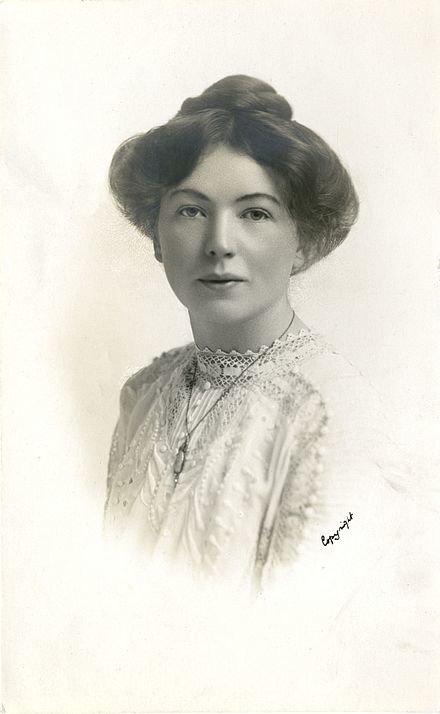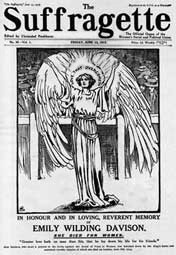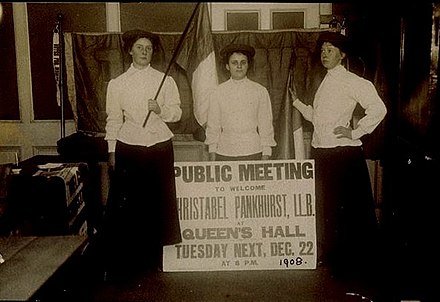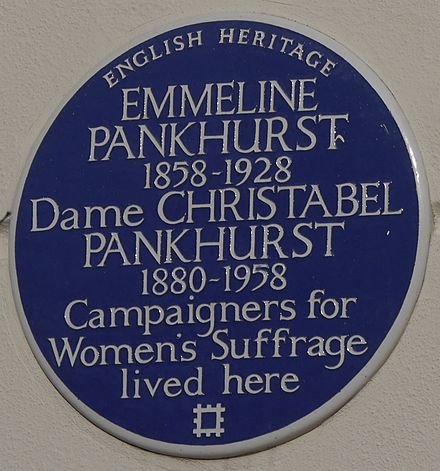British Heritage
Remember, Cherish, Learn.
beta
Christabel Pankhurst - Women's Social and Political Union (WSPU)
A Crucial Pillar of British Feminism and Social Progress.
In the annals of British history, the name Dame Christabel Harriette Pankhurst, DBE, rings with the clarion call of women's suffrage. Her relentless battle for gender equality transformed the social and political landscape of Britain and left an indelible mark on the nation's heritage. Born on 22 September 1880 in Manchester, England, Pankhurst co-founded the Women's Social and Political Union (WSPU) and spearheaded its militant actions, shaping the course of the fight for women's rights in Britain and beyond.
The daughter of pioneering suffragette Emmeline Pankhurst and radical socialist Richard Pankhurst, Christabel was no stranger to social causes from an early age. Alongside her siblings Sylvia and Adela, she was raised in a household where devotion to social reform outweighed personal comforts, even amid financial struggle. As Nancy Ellen Rupprecht aptly noted, she personified the grace, intelligence, and charisma typically associated with the first-born in a middle-class family.
Christabel was named after the titular character in Samuel Taylor Coleridge's poem, signifying her parents' fondness and special relationship with her. However, the death of her mother in 1928 profoundly affected Christabel, marking a significant event in her personal journey.
Christabel’s interest in the law led her to the University of Manchester, where she completed her degree with honours. However, her gender barred her from practising law, an unfair restriction that highlighted the need for societal change. Her activism came to the fore in 1905, when she disrupted a Liberal Party meeting with demands for women's voting rights. This act of defiance led to her arrest alongside fellow suffragette Annie Kenney, garnering substantial media attention and catalysing a surge in WSPU membership.
Following her arrest, Pankhurst relocated to the London headquarters of the WSPU and was appointed its organising secretary. Her militant activism earned her the moniker "Queen of the Mob" and multiple imprisonments. She played a crucial role in leading the WSPU while in exile in Paris between 1913 and 1914, escaping imprisonment under the Prisoner's (Temporary Discharge for Ill-Health) Act, colloquially known as the "Cat and Mouse Act".
The outbreak of World War I marked a turning point in Pankhurst’s political career. She returned to England and continued her activism despite further arrests and a hunger strike. Notably, Pankhurst advocated for the military conscription of men and the industrial conscription of women into national service. Her unwavering commitment to gender equality extended to her written work, notably her book The Great Scourge and How to End It, where she asserted that women's suffrage could help combat sexually transmitted diseases.
Pankhurst's strategies often clashed with her sister Sylvia's views, causing a rift within the WSPU. Christabel believed in prioritising the cause of suffrage over broader social issues affecting working-class women, arguing that voting rights could be a stepping stone to resolving other challenges.
Following the partial enfranchisement of women at the end of World War I, Pankhurst pursued a career in politics, narrowly losing her bid in the 1918 general election as a Women's Party candidate in the Smethwick constituency.
In 1921, she left England for the United States, where she became a prominent evangelist with the Second Adventist movement. Her later works focussed on prophetic themes, influenced by John Nelson Darby's perspectives. During this period, she adopted her daughter Betty, demonstrating her personal resilience in the face of previous familial loss.
Pankhurst’s significant contributions to society were recognised in 1936, when she was appointed a Dame Commander of the Order of the British Empire "for public and social services". However, the onset of World War II prompted her to return to the United States, where she resided in Los Angeles, California, until her death in 1958.
Her legacy continues to be celebrated today. A profile bust of Pankhurst was added to the Emmeline and Christabel Pankhurst Memorial in Victoria Tower Gardens in 1959, a testament to her impact on British society. Moreover, her name is etched on the plinth of the statue of Millicent Fawcett in Parliament Square, London, unveiled in 2018, further acknowledging her significant role in advancing women's rights.
In conclusion, Dame Christabel Pankhurst's legacy as a champion of women's suffrage is an integral part of British heritage. Her life and work exemplify the pursuit of equality and social justice, inspiring generations of activists worldwide. Through her relentless activism, both within the borders of her country and in exile, Pankhurst reshaped the political landscape of Britain, forever enshrining her place in history as a pillar of British feminism and social progress.
Life and Early Activism
The daughter of pioneering suffragette Emmeline Pankhurst and radical socialist Richard Pankhurst, Christabel was no stranger to social causes from an early age. Alongside her siblings Sylvia and Adela, she was raised in a household where devotion to social reform outweighed personal comforts, even amid financial struggle. As Nancy Ellen Rupprecht aptly noted, she personified the grace, intelligence, and charisma typically associated with the first-born in a middle-class family.
Christabel was named after the titular character in Samuel Taylor Coleridge's poem, signifying her parents' fondness and special relationship with her. However, the death of her mother in 1928 profoundly affected Christabel, marking a significant event in her personal journey.
Education and Radicalization
Christabel’s interest in the law led her to the University of Manchester, where she completed her degree with honours. However, her gender barred her from practising law, an unfair restriction that highlighted the need for societal change. Her activism came to the fore in 1905, when she disrupted a Liberal Party meeting with demands for women's voting rights. This act of defiance led to her arrest alongside fellow suffragette Annie Kenney, garnering substantial media attention and catalysing a surge in WSPU membership.
Following her arrest, Pankhurst relocated to the London headquarters of the WSPU and was appointed its organising secretary. Her militant activism earned her the moniker "Queen of the Mob" and multiple imprisonments. She played a crucial role in leading the WSPU while in exile in Paris between 1913 and 1914, escaping imprisonment under the Prisoner's (Temporary Discharge for Ill-Health) Act, colloquially known as the "Cat and Mouse Act".
Wartime Activities and Contributions
The outbreak of World War I marked a turning point in Pankhurst’s political career. She returned to England and continued her activism despite further arrests and a hunger strike. Notably, Pankhurst advocated for the military conscription of men and the industrial conscription of women into national service. Her unwavering commitment to gender equality extended to her written work, notably her book The Great Scourge and How to End It, where she asserted that women's suffrage could help combat sexually transmitted diseases.
Pankhurst's strategies often clashed with her sister Sylvia's views, causing a rift within the WSPU. Christabel believed in prioritising the cause of suffrage over broader social issues affecting working-class women, arguing that voting rights could be a stepping stone to resolving other challenges.
Post-War Activism and Later Life
Following the partial enfranchisement of women at the end of World War I, Pankhurst pursued a career in politics, narrowly losing her bid in the 1918 general election as a Women's Party candidate in the Smethwick constituency.
In 1921, she left England for the United States, where she became a prominent evangelist with the Second Adventist movement. Her later works focussed on prophetic themes, influenced by John Nelson Darby's perspectives. During this period, she adopted her daughter Betty, demonstrating her personal resilience in the face of previous familial loss.
Recognition and Legacy
Pankhurst’s significant contributions to society were recognised in 1936, when she was appointed a Dame Commander of the Order of the British Empire "for public and social services". However, the onset of World War II prompted her to return to the United States, where she resided in Los Angeles, California, until her death in 1958.
Her legacy continues to be celebrated today. A profile bust of Pankhurst was added to the Emmeline and Christabel Pankhurst Memorial in Victoria Tower Gardens in 1959, a testament to her impact on British society. Moreover, her name is etched on the plinth of the statue of Millicent Fawcett in Parliament Square, London, unveiled in 2018, further acknowledging her significant role in advancing women's rights.
In conclusion, Dame Christabel Pankhurst's legacy as a champion of women's suffrage is an integral part of British heritage. Her life and work exemplify the pursuit of equality and social justice, inspiring generations of activists worldwide. Through her relentless activism, both within the borders of her country and in exile, Pankhurst reshaped the political landscape of Britain, forever enshrining her place in history as a pillar of British feminism and social progress.
- Christabel Pankhursten.wikipedia.org









